从前边《springboot竟然有5种默认的加载路径,你未必都知道》我们知道,springboot会默认加载application.properties/application.yml配置文件,且会从下面5个默认的路径下加载,其优先级依次升高,后面的会覆盖前边的配置。我们平时使用resources/application.properties其实优先级是最低。
// Note the order is from least to most specific (last one wins)
private static final String DEFAULT_SEARCH_LOCATIONS = "classpath:/,classpath:/config/,file:./,file:./config/*/,file:./config/";既然知道了springboot会从默认的路径加载默认的配置文件application.properties/application.yml,那么必然可以自定义。
一、如何自定义这里分为两部分,一个是自定义配置文件,一个是自定义配置文件的路径。秘密就藏在上篇文章提到的一个类中:ConfigFileApplicationListener,再来看下该类的注释,下面仅贴出部分,
* <p>
* The 'spring.config.name' property can be used to specify an alternative name to load
* and the 'spring.config.location' property can be used to specify alternative search
* locations or specific files.
* <p>这段注释是什么意思呐,大体意思是“通过指定spring.config.name属性来替代默认的配置文件名称,通过指定spring.config.location属性来替代默认配置文件的加载路径”。再来看ConfigFileApplicationListener类中的属性,
/**
* The "config name" property name.
*/
public static final String CONFIG_NAME_PROPERTY = "spring.config.name";
/**
* The "config location" property name.
*/
public static final String CONFIG_LOCATION_PROPERTY = "spring.config.location";可以看到在该类中定义了两个常量来接收“spring.config.name”和“spring.config.location”属性的值。
二、如何使用上面已经了解到可以通过配置“spring.config.name”和“spring.config.location”属性值来自定义默认配置文件和默认配置文件的加载路径。现在就来试试,使用properties文件来演示,在resources文件夹下建myconfig/custom.properties,
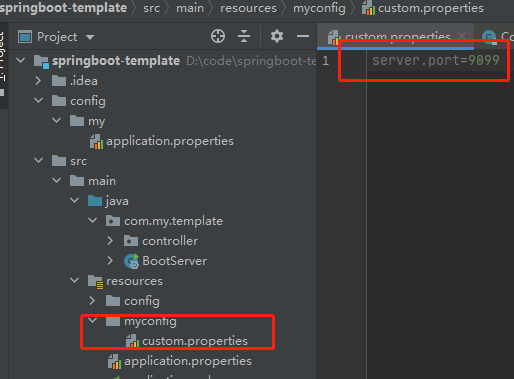
现在,如果启动服务肯定不会使用端口“9099”,因为前边说到springboot有自己的默认加载路径及默认的配置文件名,现在自定义的文件是resources/myconfig/custome.properties,springboot不会加载到,前边又说到springboot定义了“spring.config.name”和“spring.config.location”两个属性,现在就需要使用这两个属性指定自定义的配置文件。
2.1、从源码中学习如何使用要指定如何使用“spring.config.name”和“spring.config.location”两个配置,还是得去源码中寻找,前面说到这两个属性在ConfigFileApplicationListener类中,在该类中在下面的地方使用了这两个属性,
private Set<String> getSearchNames() {
//使用CONFIG_NAME_PROPERTY常量也就是spring.config.name
if (this.environment.containsProperty(CONFIG_NAME_PROPERTY)) {
String property = this.environment.getProperty(CONFIG_NAME_PROPERTY);
Set<String> names = asResolvedSet(property, null);
names.forEach(this::assertValidConfigName);
return names;
}
return asResolvedSet(ConfigFileApplicationListener.this.names, DEFAULT_NAMES);
}
private Set<String> getSearchLocations() {
Set<String> locations = getSearchLocations(CONFIG_ADDITIONAL_LOCATION_PROPERTY);
//使用CONFIG_LOCATION_PROPERTY常量也就是spring.config.location
if (this.environment.containsProperty(CONFIG_LOCATION_PROPERTY)) {
locations.addAll(getSearchLocations(CONFIG_LOCATION_PROPERTY));
}
else {
locations.addAll(
asResolvedSet(ConfigFileApplicationListener.this.searchLocations, DEFAULT_SEARCH_LOCATIONS));
}
return locations;
}从上面的代码中得出这样一个规律都是调用this.environment 中的方法,那么这个environment到底是什么,如下

完全看不出来,这时候只有通过debug了,在ConfigFileApplicationListener类中打上断点,看到environment是一个StandardServletEnvironment实例,
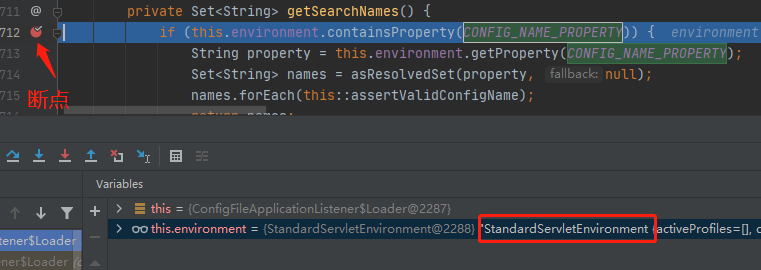
那就好办了,找到该类即可,该类中有这样的一个方法:customizePropertySources,直译过来是“自定义属性来源”,
@Override
protected void customizePropertySources(MutablePropertySources propertySources) {
propertySources.addLast(new StubPropertySource(SERVLET_CONFIG_PROPERTY_SOURCE_NAME));
propertySources.addLast(new StubPropertySource(SERVLET_CONTEXT_PROPERTY_SOURCE_NAME));
if (JndiLocatorDelegate.isDefaultJndiEnvironmentAvailable()) {
propertySources.addLast(new JndiPropertySource(JNDI_PROPERTY_SOURCE_NAME));
}
super.customizePropertySources(propertySources);
}从该类中可以看到向propertySources中新加了好几个属性,我们看下面这句,
super.customizePropertySources(propertySources);调用的是父类的方法,父类方法如下,
@Override
protected void customizePropertySources(MutablePropertySources propertySources) {
propertySources.addLast(
new PropertiesPropertySource(SYSTEM_PROPERTIES_PROPERTY_SOURCE_NAME, getSystemProperties()));
propertySources.addLast(
new SystemEnvironmentPropertySource(SYSTEM_ENVIRONMENT_PROPERTY_SOURCE_NAME, getSystemEnvironment()));
}看到又向propertySources中放入了两个值,分别是下面两个常量,
/** System environment property source name: {@value}. */
public static final String SYSTEM_ENVIRONMENT_PROPERTY_SOURCE_NAME = "systemEnvironment";
/** JVM system properties property source name: {@value}. */
public static final String SYSTEM_PROPERTIES_PROPERTY_SOURCE_NAME = "systemProperties";根据注释我们知道,
SYSTEM_ENVIRONMENT_PROPERTY_SOURCE_NAME 表示的是系统环境参数
SYSTEM_PROPERTIES_PROPERTY_SOURCE_NAME 表示的是JVM系统参数
也就是说springboot会从系统环境变量和JVM参数中读取配置信息,结合前边的分析,“spring.config.name”和“spring.config.location”会从系统环境变量和JVM参数中获取。
2.2、配置系统环境变量和JVM参数前边已经从源码中知道了“spring.config.name”和“spring.location”应该如何配置,现在看下配置效果。
2.2.1、配置JVM参数配置JVM参数看下效果,配置如下,
-Dspring.config.name=custom
-Dspring.config.location=classpath:myconfig/配置好的效果如下,

看下服务在哪个端口启动,
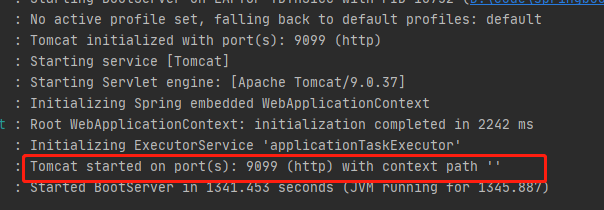
服务在端口“9099”启动,使用到了我们自定义的配置文件:resources/myconfig/custom.properties。
2.2.2、配置系统环境变量配置的信息如下,
spring.config.name=custom
spring.config.location=classpath:myconfig/配置好的效果,
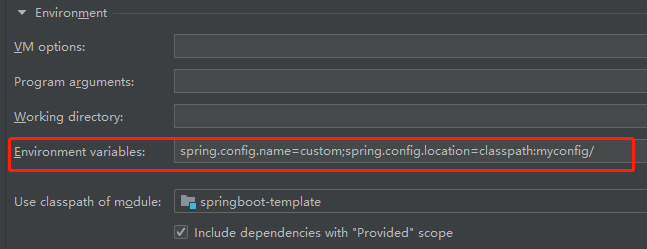
测试结果,我就不再贴了,服务使用的我们自定义的配置文件。
读到这里不知道小伙伴们是否有个疑惑,JVM参数和系统环境变量有优先级吗,当然是有的,咱们继续。
2.3、优先级之争在resources下再建myconfig2/custom.properties文件,端口为9098,
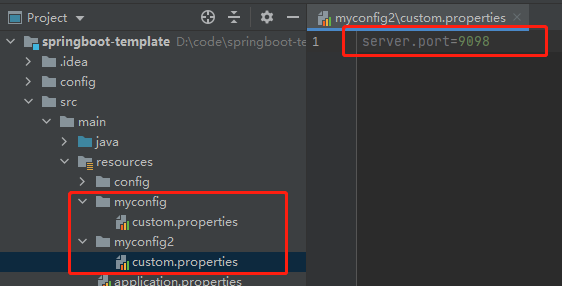
分别配置JVM参数和系统环境变量,
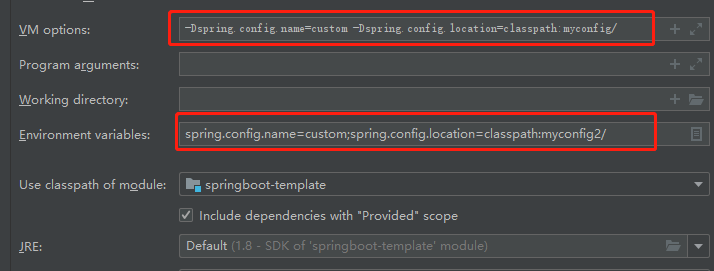
最后服务是在端口“9099”启动,
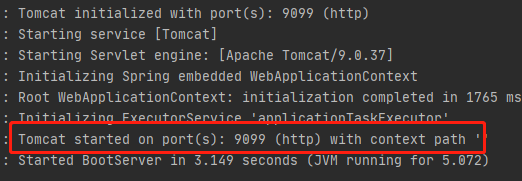
由此我们可以得出结论,JVM参数的优先级大于系统环境变量。
三、总结本文主要分享了在springboot中如何使用自定义的配置文件,主要有以下几点
1、定义自己的配置文件;
2、使用“spring.config.name”、“spring.config.location”定义文件名称、文件位置;
3、可以在JVM参数、系统环境变量配置“spring.config.name”、“spring.config.location”;JVM参数的优先级大于系统环境变量;
不知道有没有小伙伴还存在一个疑问,我是有疑问的,什么是JVM参数?什么是系统环境变量?后续咱们继续分享。
推荐阅读
《springboot竟然有5种默认的加载路径,你未必都知道》
《5分钟快速搭建一个springboot的项目》
《springboot:读取application.yml文件》

